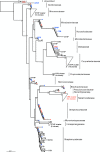Microhabitats within venomous cone snails contain diverse actinobacteria
- PMID: 19749071
- PMCID: PMC2772445
- DOI: 10.1128/AEM.01238-09
Microhabitats within venomous cone snails contain diverse actinobacteria
Abstract
Actinomycetes can be symbionts in diverse organisms, including both plants and animals. Some actinomycetes benefit their host by producing small molecule secondary metabolites; the resulting symbioses are often developmentally complex. Actinomycetes associated with three cone snails were studied. Cone snails are venomous tropical marine gastropods which have been extensively examined because of their production of peptide-based neurological toxins, but no microbiological studies have been reported on these organisms. A microhabitat approach was used in which dissected tissue from each snail was treated as an individual sample in order to explore bacteria in the tissues separately. Our results revealed a diverse, novel, and highly culturable cone snail-associated actinomycete community, with some isolates showing promising bioactivity in a neurological assay. This suggests that cone snails may represent an underexplored reservoir of novel actinomycetes of potential interest for drug discovery.
Figures




References
-
- Balick, M. J., E. Elisabethsky, and S. A. Laird. 1996. Medicinal resources of the tropical forest: biodiversity and its importance to human health. Columbia University Press, New York, NY.
-
- Birkby, K. M., and T. F. Preece. 1987. The ligules of green leaves of cock's-foot grass, Dactylis glomerata L., are a micro-habitat for bacteria and fungi. J. Appl. Microbiol. 63:505.
-
- Blunt, J. W., B. R. Copp, W. P. Hu, M. H. Munro, P. T. Northcote, and M. R. Prinsep. 2009. Marine natural products. Nat. Prod. Rep. 26:170-244. - PubMed
-
- Chun, J. 1995. Computer-assisted classification and identification of actinomycetes. Ph.D. thesis. University of Maryland, College Park.
Publication types
MeSH terms
Substances
Grants and funding
LinkOut - more resources
Full Text Sources
Other Literature Sources
Molecular Biology Databases
Research Materials

